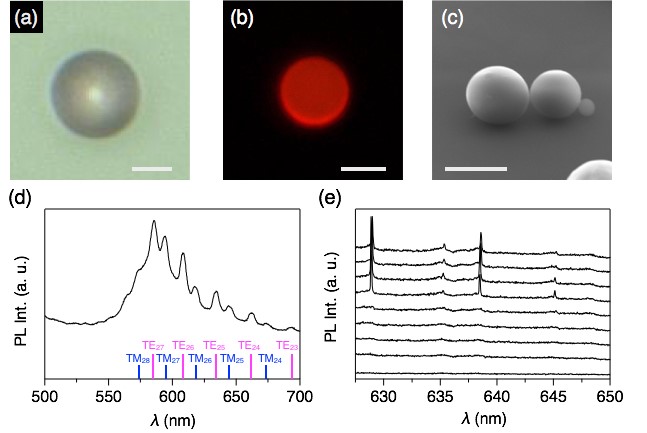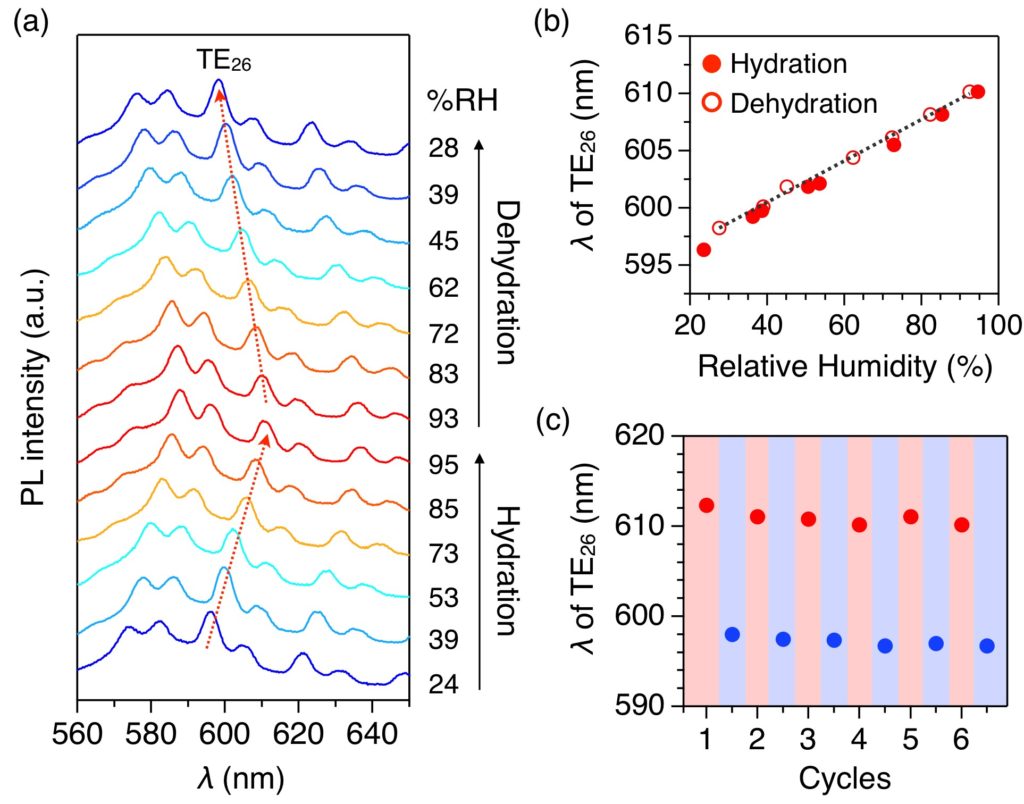Silk fibroin (SF) is a biopolymer from Bombyx mori mulberry silkworm that has been utilized as textile for millennia. Recent advancement has emphasized to the biodegradation and biocompatibility of silk for medical applications.
Due to the hydrogen bonding in silk fibroin, SF interacts with water molecules through the random coil conformation, while the β-sheet conformation provides mechanical strength to the entire spherical structure.

Figure 1. Optical (a), fluorescence (b), and SEM (c) images of the SF microspheres. Scale bars: 5 µm. (d) PL spectra of a single SF microsphere upon excitation with cw laser (λex = 450 nm). Each WGM peak is assigned as shown on the bottom. (e) PL spectra of a single SF microsphere upon excitation with fs pulsed laser.
Recently, the group of Prof. Yohei Yamamoto and collaborators of University of Tsukuba have demonstrated that self-assembled SF microspheres, doped with ionic fluorescent dye, display resonant luminescence, which shifts in response to the humidity change. The resonant peaks result from the total internal reflection of the fluorescence, causing interference at the circumference of the microspheres. The SF microspheres display lasing property upon femto-second laser pumping (Figure 1).
The WGM peaks respond to the change of the ambient humidity. When the humidity is low, SF microsphere release water molecules, leading to shrinkage of the SF microsphere and thereby causing the WGM peaks shift to the lower wavelength. In the reversal process where ambient humidity is high, SF microsphere is hydrated, causing the shift WGM of the WGM peaks to the higher wavelength (Figure 2).

Figure 2. (a) Humidity-dependent PL spectra of a single SF microsphere upon excitation with cw laser (λex = 450 nm). (b) Plot of the wavelength of the resonant peak of TE26 upon increasing (filled circle) and decreasing (open circle) the surrounding humidity. (c) Plot of the wavelength of the resonant peak of TE26 upon 6 cycles of hydration (red) and dehydration (blue) between 93 and 25 %RH.
It is interesting to highlight the secondary structure of silk fibroin. Upon treated with alcohol, β-sheet conformation is increased, providing rigid structure for the SF microspheres while the remaining random coil structure in the SF microspheres is interacting with ambient moisture. This combination contributes to the SF microsphere for obtaining a high responsivity and high sensing range toward humidity.
These properties have given a new prospect or direction for designing next generation microresonators for optical sensing or lasing applications.
Yohei Yamamoto is a professor in the department of materials Science, faculty of Pure and applied sciences, University of Tsukuba. He received his doctor degree in 2003 from Osaka University. After post-doctoral researcher term, he was appointed as an associate professor in University of Tsukuba at 2010. on 2018, he promoted to full professor in University of Tsukuba. His research interests are self-assembly of π-conjugated molecules, polymers and biomolecules to construct electronically and optically active nano/micrometer-scale materials. He is the author of more than 90 articles and cited more than 2900 times with an index H = 28.
https://publons.com/researcher/1757952//











